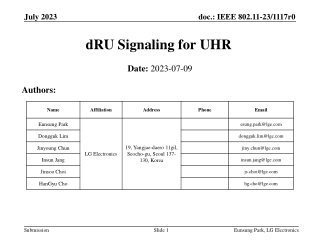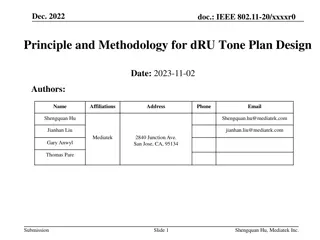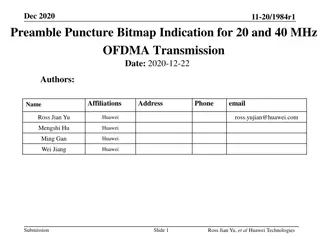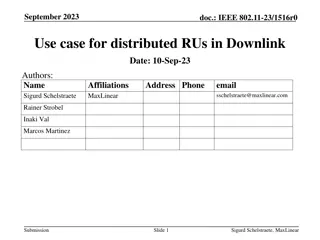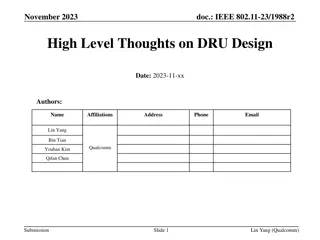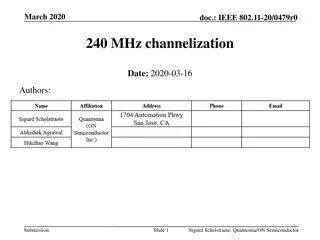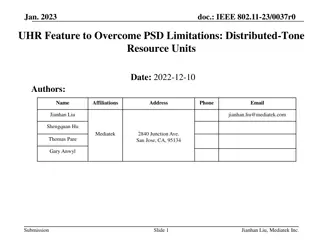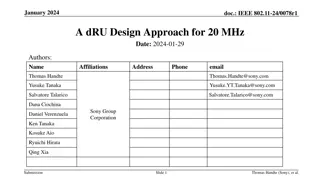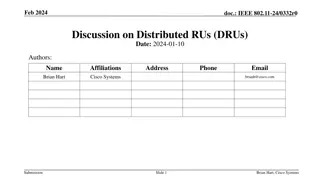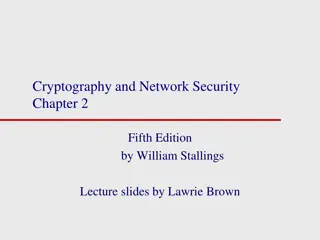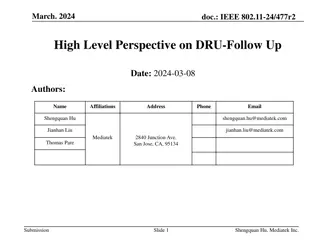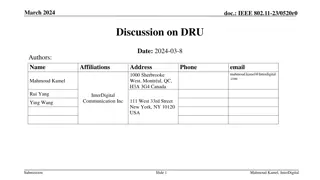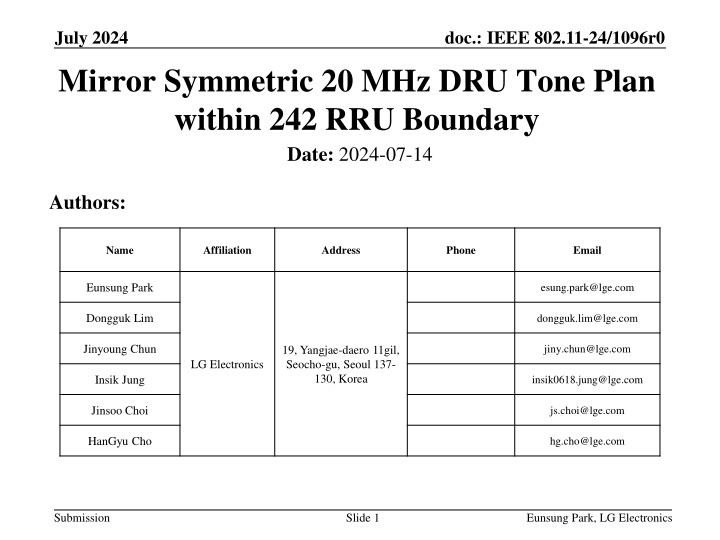
IEEE 802.11-24/1096r0: Proposed 20 MHz DRU Tone Plan within 242 RRU Boundary
In this document, a new 20 MHz DRU tone plan is proposed that guarantees the 242 RRU boundary, addressing concerns about performance degradation. The plan includes mirror symmetric properties for both data and pilot tones, ensuring improved efficiency and performance. Detailed subcarrier indices and tone allocations for various DRU types are presented, emphasizing low Peak-to-Average Power Ratio (PAPR) and enhanced smoothing gain. The proposed tone plan aims to optimize spectral efficiency and maintain compatibility within the specified boundaries.
Download Presentation

Please find below an Image/Link to download the presentation.
The content on the website is provided AS IS for your information and personal use only. It may not be sold, licensed, or shared on other websites without obtaining consent from the author. If you encounter any issues during the download, it is possible that the publisher has removed the file from their server.
You are allowed to download the files provided on this website for personal or commercial use, subject to the condition that they are used lawfully. All files are the property of their respective owners.
The content on the website is provided AS IS for your information and personal use only. It may not be sold, licensed, or shared on other websites without obtaining consent from the author.
E N D
Presentation Transcript
July 2024 doc.: IEEE 802.11-24/1096r0 Mirror Symmetric 20 MHz DRU Tone Plan within 242 RRU Boundary Date: 2024-07-14 Authors: Name Affiliation Address Phone Email Eunsung Park esung.park@lge.com Dongguk Lim dongguk.lim@lge.com Jinyoung Chun jiny.chun@lge.com 19, Yangjae-daero 11gil, Seocho-gu, Seoul 137- 130, Korea LG Electronics Insik Jung insik0618.jung@lge.com Jinsoo Choi js.choi@lge.com HanGyu Cho hg.cho@lge.com Submission Slide 1 Eunsung Park, LG Electronics
July 2024 doc.: IEEE 802.11-24/1096r0 Introduction In [1], 20 MHz DRU tone plan which tone range is within 242 RRU boundary was proposed In [2], mirror symmetric pilot tones were proposed based on the 20 MHz DRU tone plan in [1] In [3], we proposed 20 MHz DRU tone plan which has mirror symmetric property for both data and pilot tones Some of the members raised a concern about the tone range which is not within 242 RRU boundary and can cause performance degradation when this tone plan is applied to a certain 20 MHz channel in a wider bandwidth In this contribution, we propose a new 20 MHz DRU tone plan which is mirror symmetric for both data and pilot tones and guarantees 242 RRU boundary Submission Slide 2 Eunsung Park, LG Electronics
July 2024 doc.: IEEE 802.11-24/1096r0 Proposed 20 MHz DRU Tone Plan Proposed 20 MHz DRU tone plan Data and pilot subcarrier indices for Distributed Tone RUs (DRUs) in a 20 MHz UHR PPDU DRU type DRU1 [-120:9:-12, 6:9:114] [-115:9:-7, 11:9:119] DRU index and subcarrier range DRU3 [-118:9:-10, 8:9:116] DRU2 DRU4 DRU5 [-113:9:-5, 4:9:112] [-117:9:-9, 9:9:117] 26-tone DRU i=1:9 DRU6 DRU7 DRU8 DRU9 [-112:9:-4, 5:9:113] [-116:9:-8, 10:9:118] [-119:9:-11, 7:9:115] [-114:9:-6, 12:9:120] DRU1 DRU2 26-tone [DRU1, DRU2] 26-tone [DRU3, DRU4] 52-tone DRU i=1:4 DRU3 DRU4 26-tone [DRU6, DRU7] 26-tone [DRU8, DRU9] 106-tone DRU i=1:2 DRU1 DRU2 26-tone [DRU1~4], [-3, 2] 26-tone [DRU6~9], [-2, 3] [-120 ~ -4, +4 ~ +120] tones are allocated to DRUs and [-3, -2, +2, +3] tones are additionally allocated to 106 DRUs Tone range is within 242 RRU Tone spacing of 26 DRU is multiples of nine even around DC Low PAPR and better smoothing gain can be achieved The following pairs are mirror symmetric {26 DRU_a, 26 DRU_10-a}, {52 DRU_a, 52 DRU_5-a}, {106 DRU_1, 106 DRU_2} Submission Slide 3 Eunsung Park, LG Electronics
July 2024 doc.: IEEE 802.11-24/1096r0 PAPR Comparison PAPR comparison BPSK QAM 1 1 0.9 0.9 0.8 0.8 106 DRU 106 DRU 0.7 0.7 0.6 0.6 26 DRU 26 DRU 52 DRU 52 DRU CDF CDF 0.5 0.5 0.4 0.4 0.3 0.3 0.2 0.2 Proposed Tone Plan Tone Plan in [1] Proposed Tone Plan Tone Plan in [1] 0.1 0.1 0 0 0 5 10 15 0 5 10 15 PAPR [dB] BPSK PAPR [dB] QAM Two tone plans have almost same PAPR Submission Slide 4 Eunsung Park, LG Electronics
July 2024 doc.: IEEE 802.11-24/1096r0 Comparison for 20 MHz DRU Tone Plans Comparison Power Boosting Gain Within 242 RRU Boundary Channel Smoothing PAPR Implementation Proposed tone plan Simpler w/ mirror symmetry Almost same Same Possible Yes Tone plan in [1] Not symmetric Most of the previous Wi-Fi versions have symmetric tone plans If we make the DRU tone plan symmetric, we can use a similar approach for implementation used in the previous Wi-Fi. For PHY processing, we can only have information for some of the DRUs and we can use that information for their symmetric pair DRUs Further, 40 MHz tone plan proposed in [1] is almost symmetric, and thus, it would be better to make the 20 MHz tone plan symmetric as well Slide 5 Submission Eunsung Park, LG Electronics
July 2024 doc.: IEEE 802.11-24/1096r0 Proposed Pilot Tones for 20 MHz DRU Tone Plan (1/6) Design for pilot tones We use two options for pilot tones proposed in [2] which are mirror symmetric Option 1 for 26 DRUs 26 DRUs are presented in the increasing order of first tone index to show how DRU indices are allocated 26 DRU_1 26 DRU_8 26 DRU_3 26 DRU_5 26 DRU_7 26 DRU_2 26 DRU_9 26 DRU_4 26 DRU_6 Both pilot and data tones are mirror symmetric in the following pair {26 DRU_a, 26 DRU_10-a} These are also the same DRU type* *In forward or backward order of DRU, data and pilot tones are aligned with other DRUs Submission Slide 6 Eunsung Park, LG Electronics
July 2024 doc.: IEEE 802.11-24/1096r0 Proposed Pilot Tones for 20 MHz DRU Tone Plan (2/6) Option 1 for 52 DRUs 52 DRU_1 52 DRU_2 52 DRU_3 52 DRU_4 Both pilot and data tones are mirror symmetric in the following pair {52 DRU_a, 52 DRU_5-a} These are also the same DRU type Compared to option 2, pilot tone gap in each 52 DRU is rather narrow Submission Slide 7 Eunsung Park, LG Electronics
July 2024 doc.: IEEE 802.11-24/1096r0 Proposed Pilot Tones for 20 MHz DRU Tone Plan (3/6) Option 1 for 106 DRUs 106 DRU_1 {-3, 2} tones are added 106 DRU_2 {-2, 3} tones are added For a sufficient gap between pilot tones and mirror symmetry, we propose the following pilot tones (red tones) 106 DRU_1: [-52, -19, 74, 107] 106 DRU_2: [-107, -74, 19, 52] As a result, both pilot and data tones are mirror symmetric between two 106 DRUs and these are also the same DRU type Submission Slide 8 Eunsung Park, LG Electronics
July 2024 doc.: IEEE 802.11-24/1096r0 Proposed Pilot Tones for 20 MHz DRU Tone Plan (4/6) Option 2 for 26 DRUs 26 DRUs are presented in the increasing order of first tone index to show how DRU indices are allocated 26 DRU_1 26 DRU_8 26 DRU_3 26 DRU_5 26 DRU_7 26 DRU_2 26 DRU_9 26 DRU_4 26 DRU_6 Both pilot and data tones are mirror symmetric in the following pair {26 DRU_a, 26 DRU_10-a} These are also the same DRU type Submission Slide 9 Eunsung Park, LG Electronics
July 2024 doc.: IEEE 802.11-24/1096r0 Proposed Pilot Tones for 20 MHz DRU Tone Plan (5/6) Option 2 for 52 DRUs 52 DRU_1 52 DRU_2 52 DRU_3 52 DRU_4 Both pilot and data tones are mirror symmetric in the following pair {52 DRU_a, 52 DRU_5-a} These are also the same DRU type Compared to option 1, pilot tones in each 52 DRU are sufficiently spaced Submission Slide 10 Eunsung Park, LG Electronics
July 2024 doc.: IEEE 802.11-24/1096r0 Proposed Pilot Tones for 20 MHz DRU Tone Plan (6/6) Option 2 for 106 DRUs 106 DRU_1 {-3, 2} tones are added 106 DRU_2 {-2, 3} tones are added For a sufficient gap between pilot tones and mirror symmetry, we propose the following pilot tones (red tones) 106 DRU_1: [-73, -23, 53, 103] 106 DRU_2: [-103, -53, 23, 73] As a result, both pilot and data tones are mirror symmetric between two 106 DRUs and these are also the same DRU type Submission Slide 11 Eunsung Park, LG Electronics
July 2024 doc.: IEEE 802.11-24/1096r0 Conclusion We have proposed 20 MHz DRU tone plan and have compared it with the tone plan proposed in [1] Two tone plans have the same power booting gain and similar performance in terms of PAPR and smoothing and guarantees 242 RRU boundary From the implementation point of view, our proposed tone plan may be more desirable based on the mirror symmetric property We have also proposed pilot tones for our 20 MHz DRU tone plan by using two options in [2] Our complete tone plan is totally mirror symmetric The proposed pilot tones can significantly reduce DRU types We prefer option 2 since pilot tones are more sufficiently spaced than option 1 Submission Slide 12 Eunsung Park, LG Electronics
July 2024 doc.: IEEE 802.11-24/1096r0 Straw Poll #1 Do you agree to add the following text to the TGbn SFD? For DRU tone plan in 20 MHz distribution bandwidth, the following DRUs are defined Nine 26 DRUs Four 52 DRUs Each 52 DRU is combined by two different 26 DRUs Two 106 DRUs Each 106 DRU is combined by two different 52 DRUs and two different tones which are not used in any 26 or 52 DRUs Y/N/A: // Submission Slide 13 Eunsung Park, LG Electronics
July 2024 doc.: IEEE 802.11-24/1096r0 Straw Poll #2 Do you agree to add the following text to the TGbn SFD? Data and pilot subcarrier indices for DRUs in a 20 MHz UHR PPDU are defined in following table Data and pilot subcarrier indices for Distributed Tone RUs (DRUs) in a 20 MHz UHR PPDU DRU index and subcarrier range DRU1 [-120:9:-12, 6:9:114] [-115:9:-7, 11:9:119] DRU type DRU2 DRU3 DRU4 DRU5 [-118:9:-10, 8:9:116] [-113:9:-5, 4:9:112] [-117:9:-9, 9:9:117] 26-tone DRU i=1:9 DRU6 DRU7 DRU8 DRU9 [-112:9:-4, 5:9:113] [-116:9:-8, 10:9:118] [-119:9:-11, 7:9:115] [-114:9:-6, 12:9:120] DRU1 DRU2 26-tone [DRU1, DRU2] 26-tone [DRU3, DRU4] 52-tone DRU i=1:4 DRU3 DRU4 26-tone [DRU6, DRU7] 26-tone [DRU8, DRU9] 106-tone DRU i=1:2 DRU1 DRU2 26-tone [DRU1~4], [-3, 2] 26-tone [DRU6~9], [-2, 3] Y/N/A: // Submission Slide 14 Eunsung Park, LG Electronics
July 2024 doc.: IEEE 802.11-24/1096r0 Straw Poll #3 Do you agree to add the following text to the TGbn SFD? Pilot subcarrier indices for DRUs in a 20 MHz UHR PPDU are defined as follows 26 DRU_1: [-93, 33] 26 DRU_2: [-43, 83] 26 DRU_3: [-73, 53] 26 DRU_4: [-23, 103] 26 DRU_5: [-63, 63] 26 DRU_6: [-103, 23] 26 DRU_7: [-53, 73] 26 DRU_8: [-83, 43] 26 DRU_9: [-33, 93] 52 DRU_1: [-93, -43, 33, 83] 52 DRU_2: [-73, -23, 53, 103] 52 DRU_3: [-103, -53, 23, 73] 52 DRU_4: [-83, -33, 43, 93] 106 DRU_1: [-73, -23, 53, 103] 106 DRU_2: [-103, -53, 23, 73] Y/N/A: // Submission Slide 15 Eunsung Park, LG Electronics
July 2024 doc.: IEEE 802.11-24/1096r0 References [1] 11-24-0468-01-00bn-dru-tone-plan-for-11bn [2] 11-24-0800-01-00bn-dsicussions-on-dru-pilot-design-principles [3] 11-24-0767-00-00bn-20-mhz-tone-plan-and-pilot-design-for-dru-follow-up Submission Slide 16 Eunsung Park, LG Electronics

